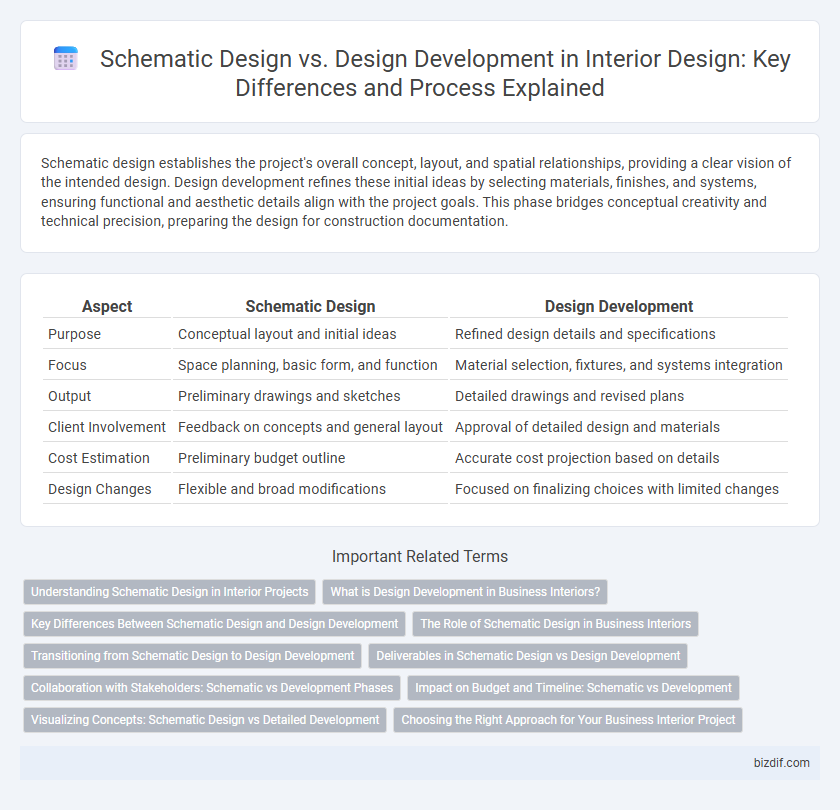Schematic design establishes the project's overall concept, layout, and spatial relationships, providing a clear vision of the intended design. Design development refines these initial ideas by selecting materials, finishes, and systems, ensuring functional and aesthetic details align with the project goals. This phase bridges conceptual creativity and technical precision, preparing the design for construction documentation.
Table of Comparison
| Aspect | Schematic Design | Design Development |
|---|---|---|
| Purpose | Conceptual layout and initial ideas | Refined design details and specifications |
| Focus | Space planning, basic form, and function | Material selection, fixtures, and systems integration |
| Output | Preliminary drawings and sketches | Detailed drawings and revised plans |
| Client Involvement | Feedback on concepts and general layout | Approval of detailed design and materials |
| Cost Estimation | Preliminary budget outline | Accurate cost projection based on details |
| Design Changes | Flexible and broad modifications | Focused on finalizing choices with limited changes |
Understanding Schematic Design in Interior Projects
Schematic design in interior projects establishes the foundational concept by defining spatial relationships, scale, and basic aesthetics, allowing clients to visualize the overall layout. This phase emphasizes rough sketches and preliminary plans to explore various design options without detailed specifications. Understanding schematic design is crucial for aligning project goals, budgets, and client preferences before advancing to design development.
What is Design Development in Business Interiors?
Design Development in business interiors refines initial concepts from schematic design into detailed plans, specifying materials, furnishings, and finishes tailored to the corporate environment. This phase ensures functional layouts optimize workspace efficiency while reflecting brand identity through color schemes, lighting, and ergonomics. Precise documentation during design development facilitates accurate cost estimation and seamless coordination with contractors and vendors.
Key Differences Between Schematic Design and Design Development
Schematic design emphasizes conceptual layouts, spatial arrangements, and basic form exploration to establish the project's overall vision, focusing on massing, scale, and initial material ideas. Design development refines these concepts by detailing dimensions, selecting specific materials, finishes, and systems, advancing toward construction documentation with coordination among architectural, structural, and MEP elements. Key differences include schematic design's broader, less detailed approach versus design development's precision and integration necessary for finalizing design intent and preparing for construction.
The Role of Schematic Design in Business Interiors
Schematic design in business interiors establishes the foundational layout and spatial relationships that align with a company's brand and workflow efficiency. It focuses on conceptualizing functional zones, circulation paths, and preliminary material selection, enabling stakeholders to visualize the project scope early. This phase sets critical parameters for design development, ensuring that subsequent detailed planning supports operational objectives and aesthetic goals.
Transitioning from Schematic Design to Design Development
Transitioning from schematic design to design development involves refining initial concepts into detailed plans with precise specifications for materials, finishes, and spatial arrangements. This stage emphasizes collaboration between interior designers, architects, and engineers to ensure feasibility, functionality, and aesthetic cohesion within the project scope. Clear communication and iterative feedback loops are essential to evolve schematic sketches into comprehensive design documents ready for construction.
Deliverables in Schematic Design vs Design Development
Schematic design deliverables include conceptual sketches, site plans, and preliminary layouts that define spatial relationships and design intent. Design development deliverables refine these concepts into detailed floor plans, elevations, and material selections, providing a clearer representation of the final project. This stage bridges the gap between conceptual ideas and construction documents, ensuring accuracy and feasibility.
Collaboration with Stakeholders: Schematic vs Development Phases
Collaboration with stakeholders during schematic design centers on gathering broad requirements and conceptual ideas to establish the project's vision and scope. In the design development phase, the focus shifts to refining those concepts with detailed input from clients, engineers, and contractors to ensure feasibility and alignment with technical specifications. This iterative collaboration enhances accuracy and helps resolve potential issues before finalizing construction documents.
Impact on Budget and Timeline: Schematic vs Development
Schematic design outlines the project's primary scope and visualizes major elements, enabling preliminary budget estimates and identifying potential cost drivers early. Design development refines these concepts with detailed specifications, which often leads to more accurate budgeting but can reveal unforeseen expenses affecting the timeline. Early investment in comprehensive schematic design reduces cost overruns and schedule delays during the development phase.
Visualizing Concepts: Schematic Design vs Detailed Development
Schematic design focuses on visualizing concepts through basic layouts and spatial relationships, establishing the project's overall vision and flow. Design development refines these ideas with detailed drawings, material selections, and precise specifications, enhancing accuracy and functionality. This phase transforms abstract concepts into actionable plans for construction and implementation.
Choosing the Right Approach for Your Business Interior Project
Schematic design establishes the foundational layout and spatial relationships of your business interior project, focusing on concepts and overall vision. Design development refines these concepts into detailed plans, integrating materials, systems, and precise specifications to ensure functionality and aesthetics align with business goals. Choosing the right approach depends on the project's complexity, budget, and timeline, ensuring efficient resource allocation and a cohesive final design.
Schematic design vs Design development Infographic

 bizdif.com
bizdif.com